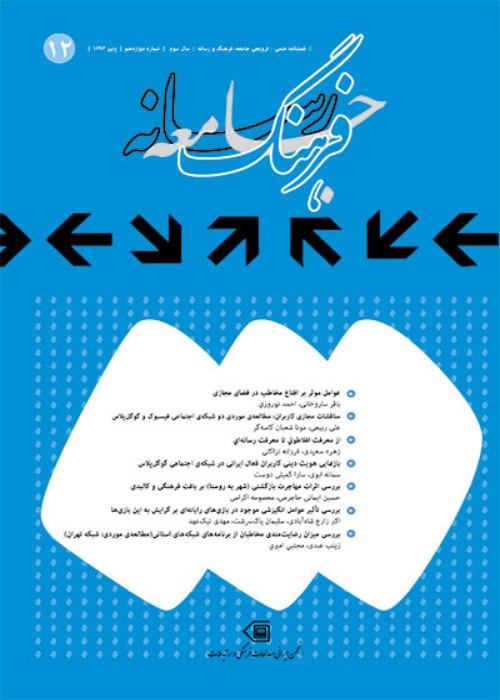Analyzing the formation processes of the public domain in cyber space with a critical ethnographic approach
Author(s):
Article Type:
Research/Original Article (دارای رتبه معتبر)
Abstract:
Background
shortly after the Web 2 revolution and the emergence of interactive virtual space, we have witnessed the rapid expansion of social networks. With the birth of the new world, all human societies are now faced with a divided world. Many researchers came to investigate and understand the relationship between humans and this new field. In order to find the coordinates of this new world, many of them evaluated human concepts in cyberspace and redefined these concepts. Conversation is the main action in Web 2, and this issue shows the importance of examining the coordinates of the public domain as a platform for public conversations in virtual space. A platform for conversation between users that both shapes the construction of the network and distributes power throughout the network. The countless capacities of virtual space promised the realization of the public sphere; On the other hand, challenges build a barrier against every human ideal, including the public domain. The purpose of this research is to understand the equations in virtual networks by looking at the rules of the public sphere; Then we can have a proper understanding of the Iranian society and we can hope for the formation of a public sphere that can bridge the gap between the private sphere of individuals and macro-political and social issues and promote them. MethodologyIn this research, critical ethnography has been used. In this research, the five main steps of Karspeakan method are used. The first stage of collecting documents and observational data has been done. In the second stage, we have made a preliminary analysis of the observational data collected in the first stage. Then, in the third stage, through interviews, we have received the opinions and points of view of the participants. Then, in the fourth stage, we have explored and identified the systemic relationships between what was discovered in the field of research and broader fields. Finally, in the fifth stage, the findings of the previous stages have been linked to the larger sociological structures. We know that no population can represent the whole truth. Each society has its own perspective that can be evaluated and compared with other groups in the social environment. In this research, the voices of different social groups have been heard and used in the research. Sampling from the number that are available directly and non-probability sampling method is used for some members of the social network to be anonymous. It starts with targeted sampling and continues based on theoretical sampling until data saturation.Results and discussionfive strengthening components and eleven weakening components of the normative and prescriptive public sphere in the context of social networks include "lack of Coherence, the lack of historical progress of the conversation, the issue of elites, the commercialization of social networks, the priority of streamlining over the creation of conversation, the limitations of the platform, the criterion of likes and followers instead of logic, context-oriented culture, "the other" hostile and polarization, lack of belief in "Social construction, disruptive groups, facilitation of communication, diversity of narratives, facilitation of the speed of information transmission, and a new arena of representation" were identified. In the end, by analyzing the components, it was found that all kinds of speech acts are taking place in social networks, if we consider the public domain to be public conversations. We must admit that all three approaches need to pay attention to the sub-discourses within themselves and the statements of other users in addition to mutual dialogue. This issue is beyond the current discussion, but one can observe changes in the various sub-discourses that are under these three main approaches in the last decade, and these changes are still ongoing. If these changes are not understood correctly, we will soon see a change in the arrangement of discourse in cyber space. In the end, it should be said that if the purpose of the current research is only to investigate the existence of virtual social networks in the public sphere at the moment. The researcher believes that this has not been achieved, but if we look at the future, we consider this possibility. It should be mentioned that the multifaceted equation of the future of Iran's complex society, on the one hand, and the hope of promoting the virtual space even beyond Web 2, i.e., the formation of Web 3, promise very diverse and sometimes exciting situations, in some of which it may be possible to form the virtual public sphere was promising even in its ideal form.Keywords:
Language:
Persian
Published:
Journal of Society Culture Media, Volume:12 Issue: 47, 2023
Pages:
153 to 180
magiran.com/p2654187
دانلود و مطالعه متن این مقاله با یکی از روشهای زیر امکان پذیر است:
اشتراک شخصی
با عضویت و پرداخت آنلاین حق اشتراک یکساله به مبلغ 1,390,000ريال میتوانید 70 عنوان مطلب دانلود کنید!
اشتراک سازمانی
به کتابخانه دانشگاه یا محل کار خود پیشنهاد کنید تا اشتراک سازمانی این پایگاه را برای دسترسی نامحدود همه کاربران به متن مطالب تهیه نمایند!
توجه!
- حق عضویت دریافتی صرف حمایت از نشریات عضو و نگهداری، تکمیل و توسعه مگیران میشود.
- پرداخت حق اشتراک و دانلود مقالات اجازه بازنشر آن در سایر رسانههای چاپی و دیجیتال را به کاربر نمیدهد.
In order to view content subscription is required
Personal subscription
Subscribe magiran.com for 70 € euros via PayPal and download 70 articles during a year.
Organization subscription
Please contact us to subscribe your university or library for unlimited access!


